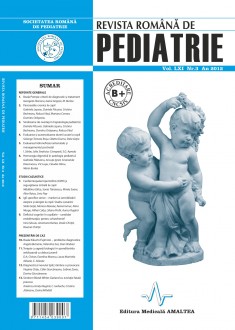SELECT ISSUE

Indexed

| |

|
|
|
| |
|
|
|

|
|
|
|
|
|
|
HIGHLIGHTS
National Awards “Science and Research”
NEW! RJP has announced the annually National Award for "Science and Research" for the best scientific articles published throughout the year in the official journal.
Read the Recommendations for the Conduct, Reporting, Editing, and Publication of Scholarly work in Medical Journals.
The published medical research literature is a global public good. Medical journal editors have a social responsibility to promote global health by publishing, whenever possible, research that furthers health worldwide.
The diagnosis of the Spitz nevus remains a challenge
Virginia Chiţu, Călin Giurcăneanu, Sabina Zurac and Dorina Giurcăneanu
REZUMAT
Introduction. Spitz nevus is a benign melanocytic lesion, most frequently met in children and in the young adult, at the level of the head and of the extremities, with a rapid evolution (months), that worries both the family and the doctor. Aim. To highlight the difficulties in diagnosing clinically, dermoscopically and histopathologically a lesion that may resemble to a melanoma.
Material and methods. We present two cases of Spitz nevus, appeared at the age of 10 and 16, respectively, as a blackish pigmented lesion and a pink, non-pigmented one, for which a consultation at the clinic was demanded, for the suspicion of malignity. Both lesions were clinically, dermoscopically and histopathologically evaluated.
Results. The suspicion of malignity being totally eliminated for the non pigmented one, classified as a classical non pigmented Spitz nevus; on the other hand, the pigmented lesion could only be classified as an atypical Spitz nevus (spitzoid tumor with uncertain malignant potential).
Conclusions: Diagnosing Spitz nevus continues to be a clinical, dermoscopic and, last but not least, histopathological challenge, and the surgical excision is recommended in most cases.
Key words: Spitz nevus, spitzoid melanoma, spitzoid tumor, starburst pattern, nevus
